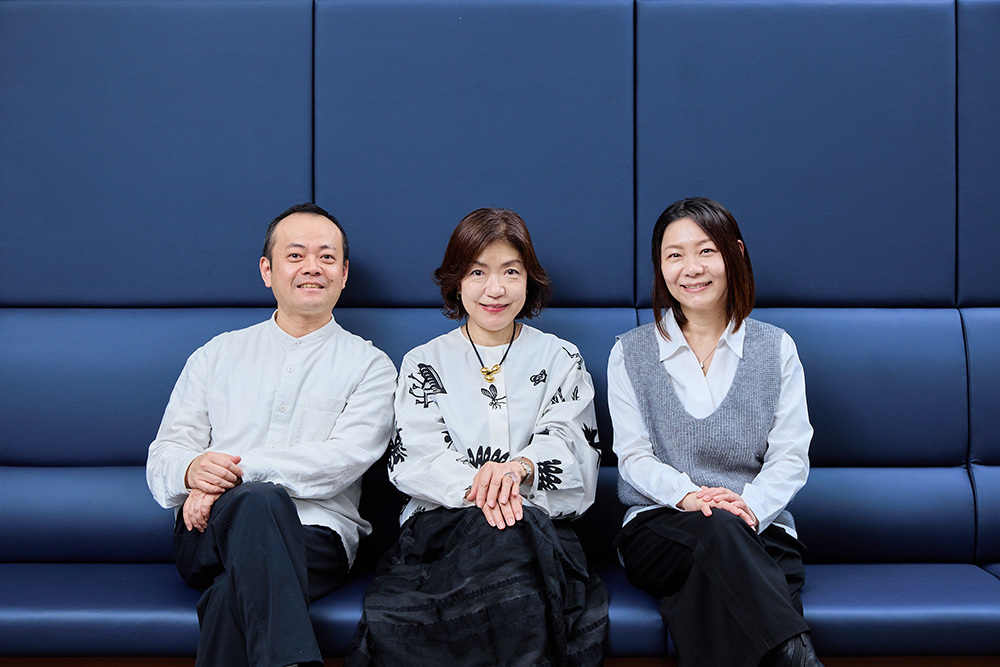
From left: Takayoshi Hayashi, Akiko Nomura, and Kazuko Maruhashi of the Min-Comu Secretariat
Dentsu Inc. in collaboration with eight domestic Dentsu Group companies has created the 'Everyone's Communication Design Guide' to achieve communication that leaves no one behind. It was made publicly available starting January 28, 2025.
This article features an interview with MinCommu Secretariat members Akiko Nomura, Takahiro Hayashi, and Kazuko Maruhashi. They delve into the impetus behind developing the guide, explain why MinCommu Design (communication design for everyone) is a vital business literacy skill for all, and discuss the significance of dentsu Japan's commitment to this initiative. Also highlighted are their tips for effectively utilizing the MinCommu Guide.
◎What is Min-Comu Design?
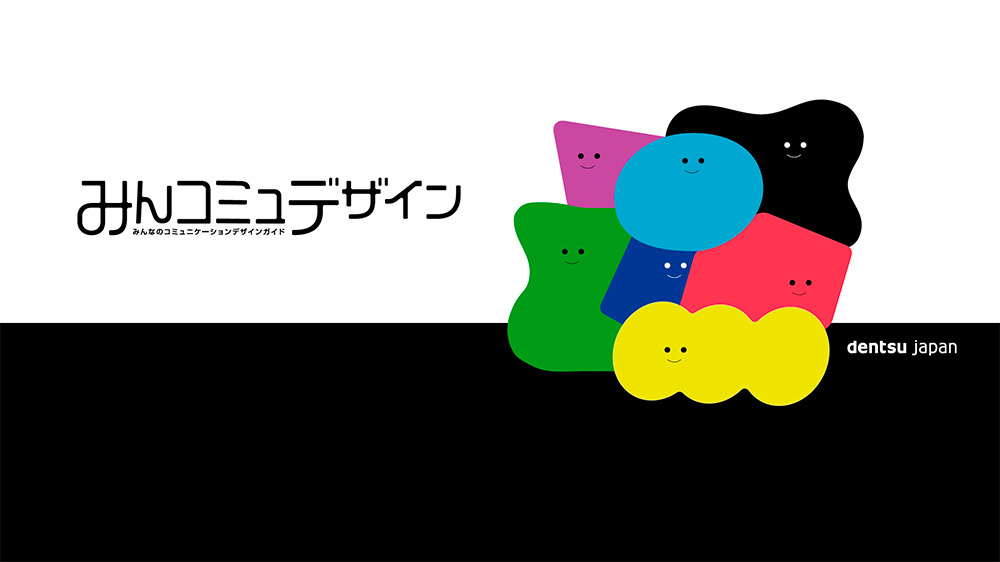
It is an approach that aims to realize ideal communication for everyone, ensuring "no one is left behind." This is based on the premise that communication recipients have diverse characteristics and needs, such as age, disability status, gender, and nationality. The Min-Comu Guide covers understanding this diverse "everyone" and the wide range of communication media that exist between sender and receiver, introducing necessary considerations and reference cases.
Why is "Min-Com Design" an essential subject for business professionals?
──First, could you explain what prompted the Dentsu Group companies in Japan to come together and create the "Min-Commu Guide"?
Nomura: In April 2024, the revised Act on the Elimination of Discrimination against Persons with Disabilities came into effect, transforming reasonable accommodations for people with disabilities from a duty of effort to a "legal obligation" for companies. Against this social backdrop, more companies are now actively promoting initiatives to address customer diversity challenges through their business operations. Previously, when companies discussed DEI*, the conversation tended to remain confined to HR, employment, internal initiatives, and risk management, making it difficult to broaden the scope.
Personally, as someone involved in promoting DEI within organizations, I found this situation extremely wasteful.
Hayashi: DEI is often perceived as the domain of specialized departments like HR, leaving little opportunity for others to engage with it. People tend to view it as unrelated to them...
Nomura: Exactly. Additionally, in 2022, we created and publicly released the "Everyone's Event Guidelines, " aiming to realize events where no one is left behind. However, it felt like we created it and then stopped. In terms of achieving the desired spread and penetration—where companies and industries actively use the guide to create implementation examples—the results still leave something to be desired.
Reflecting on this, while closely monitoring the implementation of the revised Act on the Elimination of Discrimination against Persons with Disabilities, we realized that to foster a "leave no one behind" mindset among many people, we needed to think holistically about communication—leveraging the strengths of the Dentsu Group—not just events.
We first discussed this idea with Mr. Hayashi, head of dentsu DEI innovations (formerly Dentsu Inc. Diversity Lab). From there, we brought in Art Director Mr. Maruhashi, and the secretariat was established.
※An acronym formed from the initial letters of "Diversity," "Equity," and "Inclusion."

──Another key feature is the participation of eight group companies besides Dentsu Inc.
Maruhashi: Beyond our team, employees capable of approaching DEI from domestic group companies like Dentsu Digital Inc. and Dentsu Live Inc. were dispatched to form a 30-person production team. Production proceeded under the supervision of six experts. However, a key feature of this guide is that terms like DEI and minority are deliberately not heavily emphasized.
Nomura: While DEI is the entry point, we also want people to understand that it's an essential mindset for communication in all business activities—a fundamental business literacy everyone should possess. Therefore, we aim to communicate to the 23,000 employees working across the Dentsu Group that "Min-Com Design" will become the new standard and an essential subject for business professionals.
──So "Min-Comm Design" isn't just about DEI; it's directly linked to business, right?
Hayashi: I'm involved in this project in a supervisory and collaborative capacity. The internal task force I lead, dentsu DEI innovations, is fundamentally based on the idea of contributing to diversity and inclusion through business.
This philosophy is also a core principle in creating the guide. That's why I emphasize, "Min-Comm Design isn't about social contribution; it's about our business."
How can we ensure our communication reaches everyone? It is crucial that every individual involved in various media, starting with employees of Dentsu Group, possesses this mindset and knowledge to design communication. We believe "Min-Com Design" is also an essential business skill that no one can afford to ignore, as it enables communication that leaves no one behind.
Practicing "Min-Com Design" leads to business growth and enhanced corporate value
──What is necessary to make "Min-Commu Design" more accessible and implement it in society?
Hayashi: I believe we need to spread the recognition that practicing "Min-Com Design" directly contributes to a company's business growth.
Traditional marketing focuses on reaching a targeted audience, with concentrated communication toward specific individuals being the mainstream approach. While this remains an effective method, the digital shift has enabled highly precise targeting, leading to a tendency to excessively eliminate unnecessary communication. This often results in communicating only with customers deemed valuable to the company, effectively excluding others.
However, amid a declining population due to low birth rates and an aging society, coupled with continuously increasing inbound demand, maintaining customer volume requires broadening outreach to previously untapped audiences.
Practicing "Min-Comm Design" to create touchpoints with previously unreached individuals offers significant benefits for companies. Furthermore, if this can be firmly linked to business growth rather than merely social contribution, it creates a natural necessity for companies to invest substantially in creating diverse communication channels.

Nomura: According to a 2022 survey by the Subtitled Commercial Promotion Council, subtitled commercials showed increased content comprehension, interest in products and companies, and favorability compared to non-subtitled versions. Interestingly, it also found that more respondents—including the hearing impaired, hard-of-hearing seniors, and those with normal hearing—reported improved perceptions of the companies.
Hayashi: The character for "advertisement" (広告) literally means "broadly announce." Returning to this fundamental purpose and designing communication that reaches previously underserved audiences is essential for business growth and mitigating future risks.
Perhaps what will be required going forward is a major shift in the marketing mindset we've taken for granted until now.
Nomura: In this guide, we also introduce the levels of effect achieved through Mincom Design practices using a three-star rating system. One star represents "ensuring accessibility for those directly affected," two stars signify "improving usability and creating benefits for everyone," and three stars denote "strengthening engagement and fostering loyalty between everyone and the brand." We believe aiming for three stars increases satisfaction and favorability toward the company or brand, leading to innovation and the creation of new value.
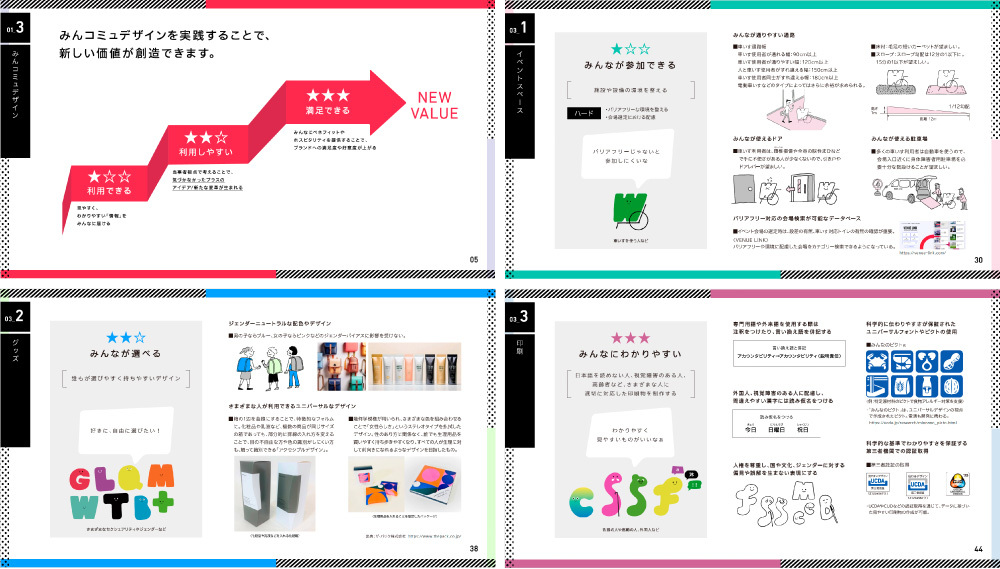
Furthermore, to achieve communication that leaves no one behind across society as a whole, we believe the concept of diversity × diversity is crucial.
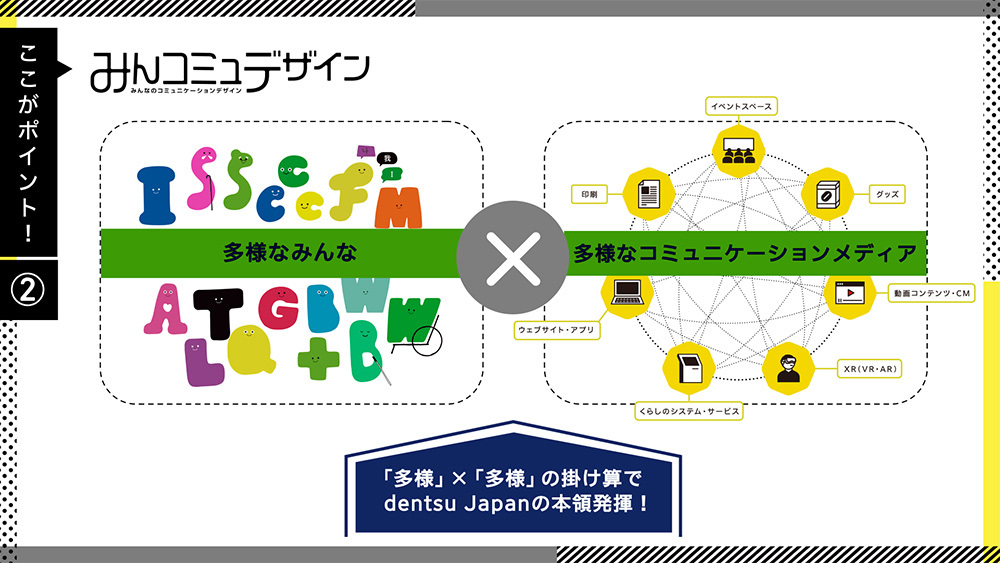
This means recognizing that the people we communicate with are diverse, and the methods we use to communicate with them are also varied. By combining these approaches, we can build communication experiences that leave no one behind, regardless of perspective. If we rely solely on a single medium—like events, video content, or the web—communication becomes limited. To avoid this, the production structure itself must be inclusive, bringing together diverse expertise.
Hayashi: The significance of creating this guide as dentsu Japan, involving not just Dentsu Inc. but our group companies, lies precisely there. Because the Dentsu Group possesses specialized expertise across various communication media, it is essential that we join hands, leveraging each other's strengths and areas of expertise. Crucially, it's about business co-creation: involving clients and the industry to collectively realize communication that "reaches everyone."
The "Min-Com Guide" isn't a textbook but a collection of key points. What's the trick to using it effectively?
──This guide meticulously considers diverse characteristics and needs of recipients, such as age, disability status, gender, and nationality, clearly introducing hints and practical examples for designing communication.
Maruhashi: The guide features a wide range of people. We tend to lump groups like people with disabilities, sexual minorities, or foreigners together, but within each group, there are diverse individuals—such as those who are totally blind, have low vision, are deaf, hard of hearing, male, female, LGBTQ+, and so on. A key feature this time is that it uses alphabet-themed characters to illustrate points explaining each group's specific needs, examples, and challenges.
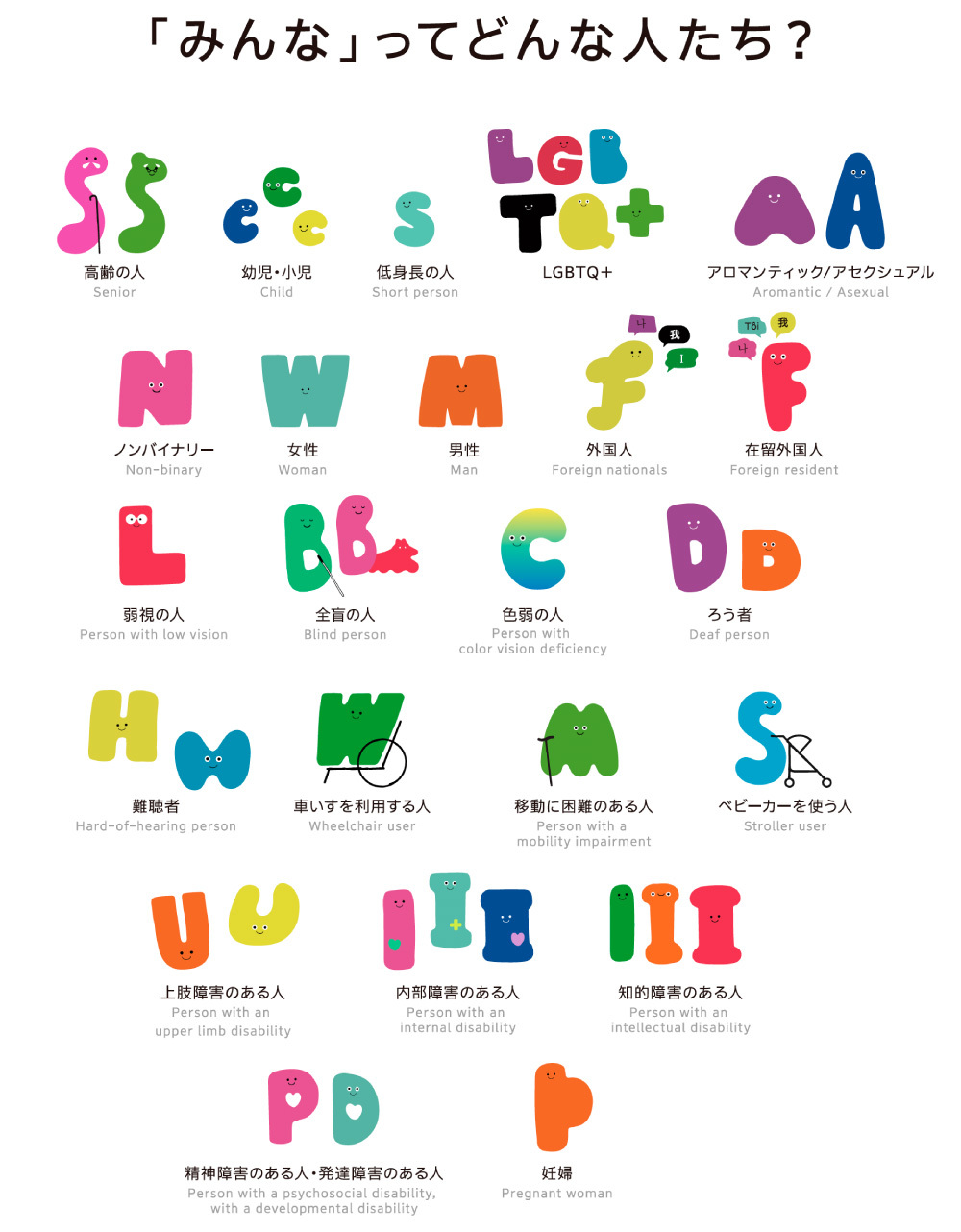
Hayashi: Exactly. We hope people will use this "Min-Com Guide" not as a textbook lecturing from 1 to 10, but as a collection of key points. Rather than trying to understand everything from the start, it's probably best to just pick up the pages that interest you.
Maruhashi: Even just flipping through this guide can spark new perspectives and potentially ignite fresh ideas, right?
Hayashi: In fact, I think it's perfectly fine to jot down your impressions or ideas as you go. For example, note down signs you spot around town or examples from overseas. The idea is for each company, industry, and communication design professional to update their own original "Min-Com Guide" as they refine it. Not everything written here is necessarily the definitive answer. Starting with this guide, I'd be thrilled if we could all think together about what diverse communication truly means.
What's needed to make "Min-Com Design" a common practice in society?
──What kind of feedback have you received since the "Min-Comu Guide" was publicly released in January 2025?
Maruhashi: Internally, we've received quite a few inquiries from our sales departments asking for study sessions. Sales staff, who frequently interact directly with client companies, likely feel a stronger sense of "I need to know this." So, having our sales representatives—who are the client-facing point of contact at Dentsu Inc.—take this initiative and study alongside our client companies feels like a very positive development.
I hope this kind of expansion and cycle will emerge in many different places going forward.

──Finally, could you share any future outlooks regarding Mincom?
Nomura: This time, we pooled the insights and know-how of Dentsu Inc. and our domestic group companies to complete the "Mincom Guide." However, we shouldn't see this as the end goal. It's crucial to create as many facts (implementation cases) as possible from here on. If we can generate cases like, "Implementing communication incorporating Mincom Design concepts led to increased favorability and fan acquisition for our company," I believe more companies will follow suit. Our next step is to aim for that.
Maruhashi: Exactly. First, based on client needs, we want to create and output creative work that puts "Min-Commu Design" into practice. By seeing how users react to it, we'll likely gain insights into our next approach.
Hayashi: I've emphasized many times that "Mincom Design" directly impacts business, but I believe the outcomes revealed by implementing it extend beyond sales and profits. It could lead to positive, non-quantifiable movements like improved recruiting or finding new collaborative partners. Moving forward, we want to establish a robust support system for clients' communication design by analyzing and providing feedback on the specific results "Mincom Design" delivers for companies.
Furthermore, rather than keeping "Min-Com Design" as a skill or shared asset exclusive to the Dentsu Group, we hope to involve the entire industry, companies, and end-users alike, making it our shared "norm."
Keeping in mind that "communication design for everyone is communication created by everyone," we as the secretariat will continue to challenge ourselves with various initiatives.
■ "Everyone's Communication Design Guide"
〈Production & Editing〉
dentsu Japan Everyone's Communication Design Project
株式会社 電通デジタル
Dentsu Digital Inc.
株式会社 電通Live Inc.
Dentsu Live Inc.
株式会社 電通プロモーションプラス
DENTSU PROMOTION PLUS INC.
株式会社 電通PRコンサルティング
PR Consulting Dentsu Inc.
株式会社 電通Creative Force Inc.
Dentsu Creative Force Inc.
株式会社 電通Live Inc.
Dentsu Live Inc.
株式会社 電通総研
DENTSU SOKEN INC.
株式会社 電通Live Inc.
Dentsu Live Inc.
株式会社 電通Live Inc.
Dentsu Live Inc.
















